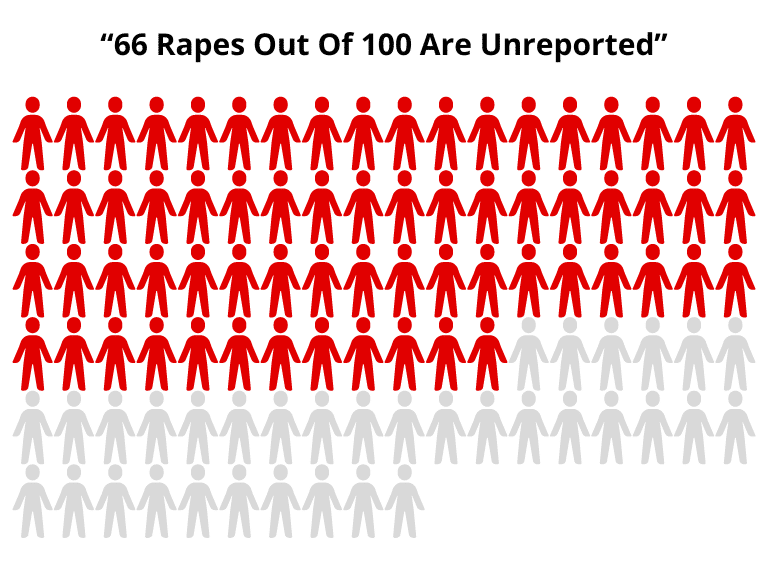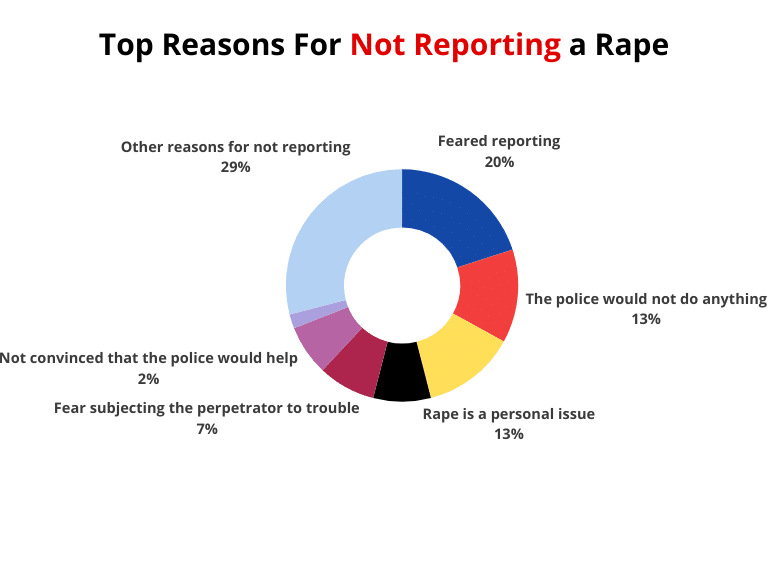This revealing report uncovers the alarming number of unreported rapes in the United States. In “Top Discoveries,” we present startling statistics, followed by an in-depth look at why many victims remain silent in “Why Are There So Many Unreported Rapes in the US?” We then discuss the significant impact on victims and society, highlight ongoing efforts to encourage reporting, and offer resources for support in “How to Help.” This report is a crucial call to awareness and action in addressing a critical, often overlooked issue.
Here’s what you can find in the report:
- Here’s The Number of Unreported Rapes in the US
- Why Are There So Many Unreported Rapes in the US?
- Impact of Unreported Rapes on Victims and Society
- Efforts and Strategies to Encourage Reporting
- How to Help: Resources and Support for Victims
Top Discoveries
- 2 out of 3 rapes are unreported. Meaning that the majority are not investigated by the police.
- Out of 1000 Sexual Assaults, 975 perpetrators will walk free.
- The top 3 reasons for not reporting a rape are:
- Fear of Retaliation (20%)
- The police would not do anything (13%)
- Rape is a personal issue (13%)
- The consequences for not reporting rape for the victim are among others:
- Physical and Emotional Trauma
- Social Stigma and Isolation
- Increased Vulnerability
- The consequences for not reporting rape for society are among others:
- Perpetuation of Violence
- Erosion of Trust in the Justice System
- Inadequate Data for Policy and Prevention
- Excessive costs for the State
- How to make victims report a rape:
- Improved Police Response and Investigation
- Third-Party Reporting Options
- Creating a Safety Culture in the Workplace
- Education and Prevention Programs
- Support Services for Victims
- Confidential Reporting Systems
- Community Engagement
Here’s The Number of Unreported Rapes in the US
- 2 out of 3 rapes are unreported (66%). Meaning that only 1 out of 3 rape is reported to the police. That’s 66 persons out of 100 persons that do not report that they have been raped.
- There on average 463,634 sexual assault victims in the US every year. This means that this is the reported number accounting for only 33% of the total number. So in other words, there are 927,268 cases we don’t hear about because they go unreported. Read further below to see why people don’t report a rape.
- Out of 1.000 Sexual Assaults 975 perpetrators will walk free:
- 310 are reported to the police
- 50 reports lead to arrest
- 28 cases will lead to a felony conviction
- 25 perpetrators will be incarcerated

Why Are There So Many Unreported Rapes in the US?
The United States faces a significant challenge with the underreporting of rape and sexual violence. Understanding why many survivors choose not to report these crimes to the police is crucial in addressing this issue. Data from 2005 to 2010 provides insight into the reasons behind this underreporting.
Among sexual violence crimes not reported to the police, several reasons stand out:
Fear of Retaliation: About 20% of victims did not report due to the fear of retaliation from the perpetrator. This fear can be both physical and psychological, encompassing concerns about personal safety as well as social and professional consequences.
Belief in Police Ineffectiveness: A total of 13% of victims believed that the police would not or could not help, indicating a lack of trust in the criminal justice system to provide support or deliver justice.
Perception of Assault as a Personal Matter: Another 13% viewed the assault as a personal or private issue, suggesting a reluctance to share intimate or traumatic experiences with authorities or a belief that sexual violence is not a public concern.
Reporting to Other Officials: Some victims (8%) chose to report the incident to a different official, which might indicate a preference for handling the matter within certain institutions or communities instead of involving law enforcement.
Perceived Insignificance of the Incident: A belief that the incident was not important enough to report was cited by 8% of victims, reflecting possible minimization of the assault or a belief that the incident does not meet the threshold for criminal investigation.
Reluctance to Punish the Perpetrator: Around 7% did not want to get the perpetrator in trouble, often seen in cases where the perpetrator is a known and close individual to the victim.
Diverse and Unspecified Reasons: Approximately 30% of victims gave other reasons or did not cite a specific reason for not reporting, indicating a wide range of personal, social, and systemic factors influencing the decision to report.
In contrast, among those who did report sexual violence to the police, the primary motivations were to a) protect one’s self or others from further crimes, b) to stop the incident or prevent its recurrence, and c) a sense of duty or a desire to improve police surveillance (these 3 reasons accounts for 74% for why to report a rape).
These findings highlight the complex interplay of personal, social, and systemic factors that influence a survivor’s decision to report or not report sexual violence. Addressing these concerns requires a multi-faceted approach, including enhancing the responsiveness and effectiveness of the justice system, providing adequate support and resources for survivors, and creating a societal environment where survivors feel safe and validated in coming forward
| Reason For Not Reporting | Rate |
|---|---|
| Feared reporting | 20% |
| The police would not do anything | 13% |
| Rape is a personal issue | 13% |
| Not essential to report | 8% |
| Report to a completely different official | 8% |
| Fear subjecting the perpetrator to trouble | 7% |
| Not convinced that the police would help | 2% |
| Other reasons for not reporting | 30% |

Impact of Unreported Rapes on Victims and Society
The underreporting of rape and sexual assault has profound effects on both victims and society. Research shows that about 66% of rapes and sexual assaults go unreported in the United States, largely due to factors such as fear, stigma, and distrust in the justice system. This lack of reporting leaves a vast majority of perpetrators unaccountable, potentially enabling further crimes.
For victims, the impact is multidimensional
- Physical and Emotional Trauma: Victims of unreported rapes carry the burden of physical and psychological trauma, often without adequate support or counseling. This can lead to long-term mental health issues, such as post-traumatic stress disorder, anxiety, and depression.
- Social Stigma and Isolation: Victims might suffer from social stigma and a sense of isolation, especially if they feel they cannot disclose the assault to friends or family members. This can exacerbate feelings of loneliness and misunderstanding.
- Increased Vulnerability: Without reporting the crime, victims may be at a heightened risk of future assaults. Studies indicate that people who were abused in childhood are at greater risk of being abused again.
The societal implications are equally significant:
- Perpetuation of Violence: When assaults go unreported, perpetrators remain free, potentially continuing their abusive behavior and contributing to a cycle of violence. There is fear and anger in schools, campuses, workplaces, and religious communities whenever there is an incident of rape in the community. Such a scare might impact the productivity of any society.
- Erosion of Trust in the Justice System: The high rate of underreporting can erode public trust in the justice system’s ability to effectively address sexual violence.
- Inadequate Data for Policy and Prevention: Underreporting results in a lack of accurate data, which is crucial for shaping effective public policies and prevention strategies.
- Excessive costs for the State: The society will have to bear some financial costs. These costs include mental health and medical services, productivity, and legal expenses. The costs associated with rape are great. According to the United States Department of Justice, rape costs per year is about $127 billion. Every rape costs about $151,423. So, it is evident that rape imposes an economic strain on society, even though only a small number of victims of unreported rape cases get the necessary treatment. According to the Department of Justice, between 1992 and 2000, only 22% of rape victims injured from unreported rape were treated.
To address these issues, it’s essential to foster environments where victims feel safe and supported in coming forward, and where their reports are met with a swift and empathetic response. This involves not only improvements in the legal and social systems but also broad cultural changes in how we perceive and discuss sexual violence. The next section talks about how to encourage rape victims to report the violence.
Efforts and Strategies to Encourage Reporting
Efforts and strategies to encourage the reporting of sexual assaults are vital in addressing and mitigating this serious issue. Here are some key strategies and efforts that can be implemented to get the victims to report their rape:
Improved Police Response and Investigation: Law enforcement agencies can adopt trauma-informed interviewing strategies that respect the victim and encourage them to share their experiences without feeling judged or disbelieved. Police officers should be trained to address biases and stereotypes about victims and to treat all victims with respect. Policies should support thorough and effective investigations, ensuring that reports are appropriately classified and referred to suitable services.
Third-Party Reporting Options: Some victims may feel more comfortable sharing information through third parties, such as rape crisis centers. Law enforcement agencies can facilitate this by allowing and maintaining third-party reports separately unless the victim decides to file a formal report. This approach respects the victim’s choice while still gathering potentially crucial information.
Creating a Safety Culture in the Workplace: Employers can proactively create an environment that encourages reporting. This includes establishing a zero-tolerance policy towards violence, conducting background checks on new employees, and creating open lines of communication where employees feel safe to report incidents. Monitoring and security measures, such as surveillance and visitor management, can also play a significant role.
Education and Prevention Programs: Educating staff and community members about the signs of sexual assault, how to report it, and the support available is crucial. This education can be done through training programs, workshops, and awareness campaigns. By increasing awareness, individuals are more likely to recognize and report incidents.
Support Services for Victims: Providing accessible, comprehensive support services for victims is essential. This includes medical, legal, psychological, and emotional support. Knowing that these services are available can encourage victims to come forward.
Confidential Reporting Systems: Establishing confidential reporting systems where victims can share their experiences without fear of exposure or retaliation can significantly encourage reporting. These systems can assure victims that their identities and the details of their incidents will be handled with utmost confidentiality.
Community Engagement: Engaging the community in discussions about sexual assault, its impact, and the importance of reporting can create a more supportive environment for victims. Community programs can also provide resources and support for victims and their families.
These strategies, while varied, share a common goal: to create environments, both in the community and in specific settings like the workplace, where victims of sexual assault feel supported, believed, and empowered to report their experiences. This, in turn, can lead to more effective responses, better support for victims, and a reduction in the incidence of sexual assault, or at least that victims dare to report the rape.
How to Help: Resources and Support for Victims
If you or someone you know has been a victim of rape, there are numerous resources available offering support and assistance. Here are 5 different ways to get help and support for rape victims:
- Hotlines:
- National Sexual Assault Hotline: Operated by RAINN (Rape, Abuse & Incest National Network), this hotline offers confidential support 24/7. You can reach them at 1-800-656-HOPE (4673) or via their online chat service.
- VictimConnect Resource Center: Offers support and information about rights and options for victims. Contact them at 1-855-4VICTIM (855-484-2846) or chat online.
- Medical and Legal Support:
- Local rape crisis centers can provide counseling, crisis intervention, legal information, and medical services. The National Sexual Violence Resource Center maintains a directory of organizations to help you find local resources.
- For legal assistance, WomensLaw.org offers information on restraining orders and legal protections. They also provide an email hotline for further support.
- Specialized Support:
- For LGBTQ survivors, resources like The Network/La Red and The Trevor Project offer support and advocacy. The Network/La Red’s hotline is 617.742.4911, and The Trevor Project’s is 866.488.7386.
- For survivors of human trafficking, the National Human Trafficking Hotline assists at 1-888-373-7888.
- Online Support:
- Online support options include RAINN’s online rape support hotline through hotline.rainn.org for crisis intervention and referrals.
- Websites like After Silence and Daily Strength provide online support groups, educational material, and forums for rape survivors.
- In-Person Support:
- Local rape crisis centers often offer in-person support. You can locate these centers through your local police department, hospital emergency room, or the National Sexual Assault Hotline.
- The National Center for Victims of Crime also offers support and can be contacted at 1-800-FYI-CALL.
Remember, reaching out for help is crucial in healing and recovery. Whether it’s through hotlines, local resources, or online platforms, support is available for survivors of rape and their loved ones.
Sources: Nsvrc.org, Ballardbrief, Brennancenter, Rainn, and Bureau of Justice Statistics












